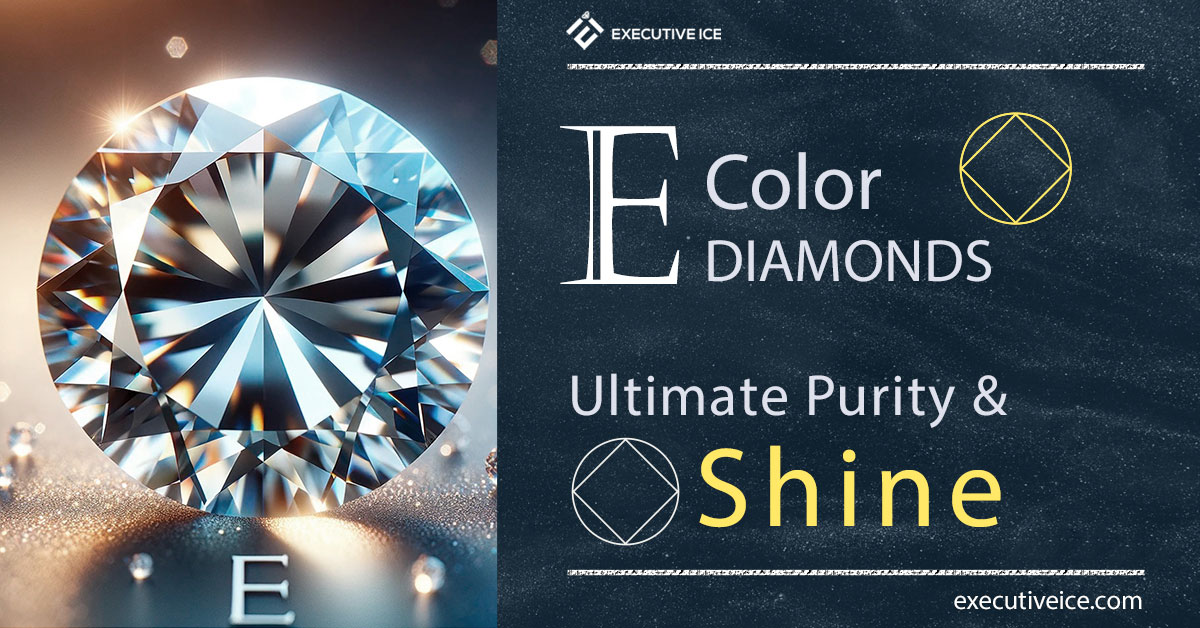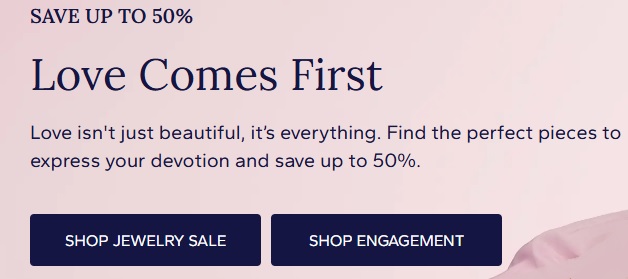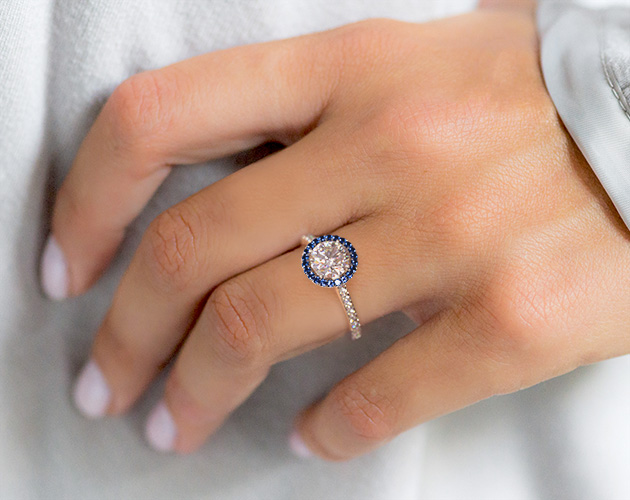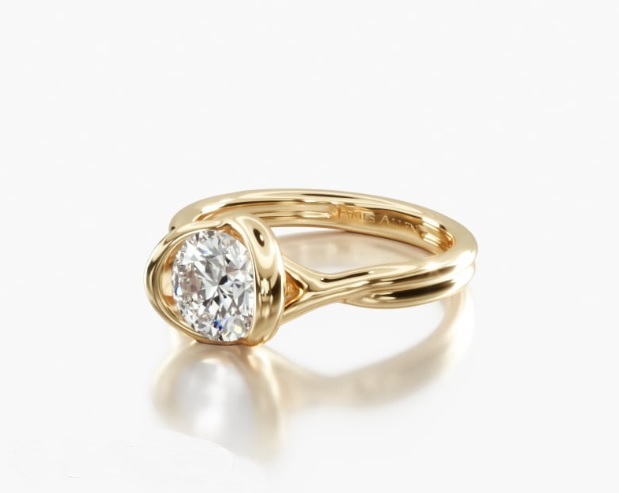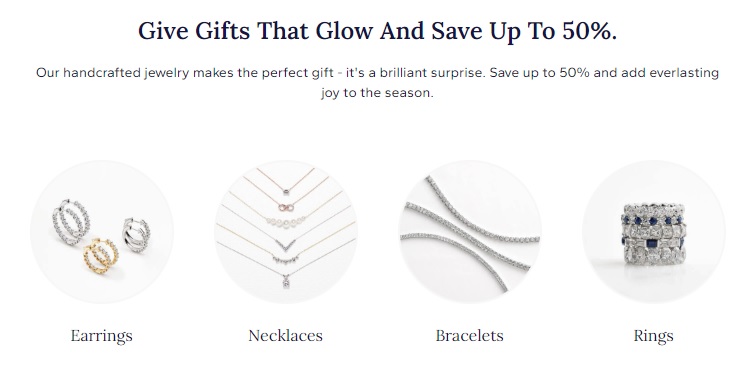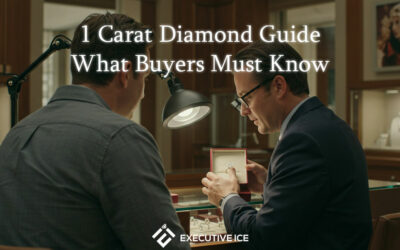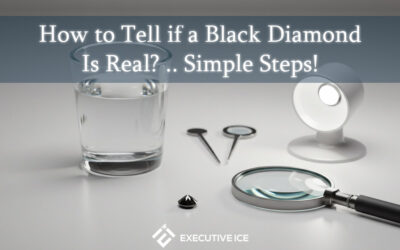E Color Diamonds represent the pinnacle of near-colorless perfection, offering a subtle distinction from the absolute colorlessness of D grade diamonds.
This article delves into the nuanced world of E color diamonds, providing insights into their meaning, how they stand up against D color diamonds in visual comparison, and what factors influence their pricing.
You will gain a comprehensive understanding of why E color diamonds are highly sought after for their exceptional purity and brilliance, making them a favored choice for those seeking the perfect quality in their diamond selection.
Whether you’re considering an investment or selecting a timeless piece of jewelry, this guide will equip you with the knowledge to appreciate the unique beauty and value of E color diamonds.
Understanding E Color Diamonds
E color diamonds are a marvel in the world of gemstones, nestled just a step below the top color grade on the diamond color scale. When we talk about E color grading, we’re referring to diamonds that possess an exceptional degree of colorlessness, with only minute traces of color detectable by expert gemologists under specific lighting conditions.
These diamonds fall within the ‘Colorless’ category, which is the highest tier of the diamond color grading system established by the Gemological Institute of America (GIA). This prestigious category also includes D and F color diamonds, making E color diamonds highly sought after for their purity and radiance.
The characteristics of E color diamonds are fascinating. Although they contain slight color differences when compared directly to D grade diamonds, these nuances are virtually indistinguishable to the untrained eye, especially once the diamond is set in jewelry. The near-absence of color in E diamonds allows for maximum light reflection and refraction, resulting in a brilliant sparkle and fire that diamond lovers cherish.
Choosing an E color diamond means selecting a stone that embodies both rarity and exceptional beauty. These diamonds provide an exquisite balance, offering the allure of a colorless diamond at a value that distinguishes them from the absolute colorlessness of a D grade, making them an excellent choice for engagement rings, earrings, and other fine jewelry that aim to captivate and enchant.
Where E Color Diamonds Fit in the Spectrum
E color diamonds shine brightly in the grand spectrum of diamond colors, occupying a prestigious position just a whisper away from the absolute colorlessness of D grade diamonds. These gems are part of the elite group classified as ‘Colorless’ by gemological standards, which also includes D and F color diamonds.
Positioned second in the color grading scale, E color diamonds offer a purity and brilliance that is nearly indistinguishable to all but the most trained eye, especially when set in jewelry.
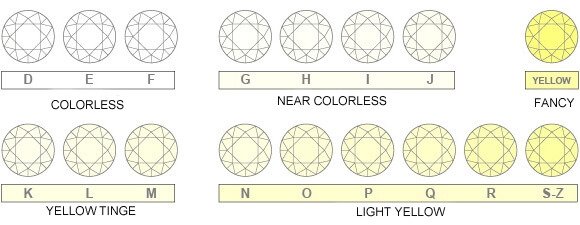
This article will guide you through the luminous world of E color diamonds, highlighting their place in the color spectrum and showcasing why they are a cherished choice for those seeking exceptional beauty in their diamond selections.
With E color diamonds, you’re embracing a level of colorlessness that promises not only to captivate but to enchant with its subtle, pristine beauty.
Visual Differences Between E Color and Other Diamond Color Grades
Navigating the nuanced world of diamond color grades, especially the subtle shades separating E color diamonds from their close neighbors, is akin to appreciating the delicate changes of the seasons.
Each color grade, from the pristine D to the slightly tinted G and beyond, holds its own unique beauty, much like the variations in a sunset’s hues.
-
E vs D and F
E color diamonds sit almost at the peak of the diamond color scale, a step below the completely colorless D grade. To the untrained eye, the distinction between D and E color diamonds is nearly imperceptible, especially once the diamond is set in a piece of jewelry.
Both exhibit a stunning lack of color but under the scrutinizing lens of a gemologist, E color diamonds might reveal a minuscule hint of color that D diamonds do not possess.
Displayed here is a D color diamond alongside a nearly identical gem, distinguished only by its E color grade, with an F color diamond also presented for comparison:

-
E vs G
Moving down the color scale to G grade, which still fall within the ‘Near Colorless’ category, the differences become slightly more apparent, yet they require a discerning eye to detect.
E color diamonds maintain a level of colorlessness that makes them highly desirable, offering a purity that is very close to D diamonds but at a potentially more accessible price point.
-
E vs Other Color Grades
As we venture further to G and beyond, into the realm of H, I, and J colors, the warmth in the diamonds becomes more noticeable, especially when compared side by side with an E color diamond.
These diamonds might display a gentle hue, reminiscent of the warm glow at dawn, which can add depth and character depending on personal taste and the diamond’s setting.
The beauty of E color diamonds lies in their ability to blend the lines between absolute colorlessness and the faintest whispers of hue, offering a sparkle and brilliance that captivates the heart.
Whether set against the rich backdrop of yellow gold or the bright sheen of platinum, E color diamonds shine with an inner light, making them a cherished choice for those seeking a blend of exceptional quality and subtle, natural beauty in their diamond selection.
Choosing Between E Color and Other Grades
When standing at the crossroads of deciding on the perfect diamond, the choice between an E color grade and other color grades might seem daunting. Yet, it’s a decision that intertwines with your personal taste, budget considerations, and the setting you envision for your diamond. Here’s some advice to guide you through this selection process.
-
Aesthetic Preferences:
Begin with your heart and what catches your eye. E color diamonds offer a pristine near-colorlessness that’s hard to distinguish from the absolute colorlessness of a D grade, especially to the untrained eye.
If your heart leans towards something that embodies both purity and a slight touch of warmth, venturing into F or G color grades could be rewarding.
-
Budget Considerations:
Your budget plays a crucial role in this decision. E color diamonds, residing at the high end of the color scale, command a premium. If you’re seeking a balance between a high-quality appearance and cost-effectiveness, comparing E with F or G grades might reveal opportunities to allocate funds towards other characteristics, like cut or carat, without compromising the diamond’s allure.
-
The Setting:
The metal in which you plan to set your diamond can influence your color choice. E color diamonds complement both white and yellow gold, as their near-colorless nature shines brightly against any backdrop.
However, if you prefer a warmer setting, like yellow gold or rose gold, you might find that diamonds with a slight hint of color blend harmoniously, offering flexibility without diminishing the diamond’s beauty.
-
Light Performance:
Consider how each color grade reflects light. E color diamonds, much like their D counterparts, excel in brilliance and fire, making them a dazzling choice for those who value sparkle above all.
Yet, even diamonds with a slight color can exhibit remarkable light performance when expertly cut, marrying brilliance with a hint of warmth.
In the end, choosing an E color diamond—or any other grade—is about finding harmony between your desires, practical considerations, and the diamond’s natural beauty. Let your preferences guide you, supported by thoughtful consideration of how each aspect contributes to creating a piece that resonates with your personal story and style.
E Color Diamonds in Various Settings
Embarking on the journey to find the perfect home for an E color diamond is like choosing the right landscape to complement the sky’s natural brilliance. These nearly colorless gems interact with their settings in ways that can accentuate their beauty, whether nestled in the cool embrace of white gold, the classic elegance of platinum, or the warm glow of yellow gold.
-
White Gold:
White gold provides a sleek and modern backdrop that amplifies the near-colorless radiance of E color diamonds. This setting creates a seamless flow of light, making the diamond appear even more luminous and vibrant.
It’s a harmonious match that highlights the diamond’s pure sparkle without any color distraction.
Here’s an example of what it might look like👇
1.00 Carat Round Diamond E Color – SI1 Clarity – Excellent Cut
18K White Gold 1.5mm Comfort Fit Engagement Ring
Image Source: James Allen
-
Platinum:
Platinum, with its natural white sheen and strength, offers a sanctuary of durability and sophistication for E color diamonds. This metal’s resilience pairs beautifully with the timeless elegance of E color gems, ensuring that their brilliance is showcased to its fullest. The combination speaks of enduring love and legacy, much like the steadfast mountains.
Take a look at this example below👇
1.00 Carat Round Diamond E Color – SI1 Clarity – Excellent Cut
Platinum French Cut Pavé Blue Sapphire Engagement Ring
Image Source: James Allen
-
Yellow Gold:
Yellow gold brings a warmth that contrasts subtly with the cool brilliance of an E color diamond, drawing out its purity in a dance of light. This classic setting offers a striking visual appeal, where the diamond’s near-colorless nature is accentuated against the rich hue of the gold, much like sunlight piercing through the golden hour.
See the example provided below👇
1.00 Carat Round Diamond E Color – SI1 Clarity – Excellent Cut
18K Yellow Gold Half Bezel Knot Solitaire Engagement Ring
Image Source: James Allen
Choosing the right setting for your E color diamond is a journey of balance and beauty, where the metal’s hue and the diamond’s light perform together in harmony. Each setting offers a unique way to showcase the pristine quality of an E color diamond, allowing its natural brilliance to shine in the way that best matches your personal narrative and style.
E Color Diamond Price
Diamond prices are influenced by a multitude of factors, notably the 4Cs (color included) and other significant but less well-known elements such as polish, symmetry, and the diamond’s table and depth dimensions.
A search on James Allen for diamonds with 1 carat, Ideal cut, and VS2 clarity reveals a range of 10 diamonds priced between $6,170 and $8,890. (At the time of writing)
A similar search on Blue Nile yields comparable figures, with prices for diamonds of the same specifications fluctuating between $5,120 and $8,780. (At the time of writing)
It is important to note that prices for other shapes tend to be slightly lower, yet here we focus on the round shape due to its popularity.
-
2 carat e color diamond price
Increasing the carat size to 2 results in a significant jump in price, starting at $21,000, which underscores the exponential increase in value with size.
-
E Color Diamond Price compared to other grades
D color diamonds command a slightly higher price than E color diamonds, moving down the color scale from E and F grades, the price decrease becomes more noticeable.
For instance, a G color diamond with 1 carat, Ideal cut, and VS2 clarity from James Allen costs start at $4,020, which is approximately $1,100 less than its E color counterpart. An I color diamond from James Allen, still sufficiently colorless to shine in settings like white gold or platinum, is priced even lower at $2,710. This represents approximately a saving of $2,410 compared to an E color diamond, while still looking nearly indistinguishable in most settings apart from a halo outside of a laboratory environment.
Pro Tip:
(A useful tip is to consider diamonds within the IJK color range that exhibit medium to strong blue fluorescence. Such diamonds can counteract any yellowish hue and may appear brighter, avoiding the haze or cloudiness that can be seen in some colorless diamonds with fluorescence. For example, a J color diamond with strong blue fluorescence from James Allen is $390 less expensive than an I color diamond, yet it appears remarkably similar.)
Opting for a lower color grade allows you to allocate more budget towards aspects of a diamond that have a greater impact on its appearance, such as cut quality or carat size, which are far more noticeable than color. Choosing a diamond with a G or H color grade, or even I or J in certain settings, might enable you to acquire a more visually striking diamond for the same investment.
We’ve delved deeper into this, offering advice on fancy shape diamonds and customized engagement rings.
Investing in E Color Diamonds
E color diamonds stand among the most elusive and rare color grades in the diamond spectrum. Their rarity and limited availability naturally safeguard your investment, ensuring that these gems maintain their value over time due to their scarcity.
Despite this allure, some investors and collectors may question the premium associated with E color diamonds, considering whether the investment merits the cost. This hesitation often stems from the availability of near-colorless diamonds, which come at a lower price point yet still present a white appearance when set in jewelry.
These near-colorless alternatives offer a compelling choice for those seeking the balance between aesthetic beauty and cost-effectiveness, challenging the notion of value attached to the slight color distinctions within the highest tiers of the color scale.
Where To Buy E Color Diamonds
Selecting a reputable vendor is crucial when purchasing any diamond to ensure you receive fair value without being misled into paying a premium for subpar quality.
This becomes particularly vital when considering E color diamonds, where the subtle visual differences and price variations make it easier for less scrupulous sellers to misrepresent a diamond’s true grade, potentially selling lower-grade diamonds at the price of an E color grade.
For a trustworthy diamond buying experience, we endorse James Allen and Blue Nile as premier choices. Both retailers boast an extensive selection of GIA-certified diamonds, providing assurance that the diamond’s grade is both accurate and reliable.
Furthermore, James Allen and Blue Nile enhance the shopping experience by offering advanced diamond inspection tools. Their high-quality, 360° imagery allows you to meticulously examine every facet of a diamond from the comfort of your home, ensuring you make an informed and confident purchase decision.
FAQs About E Color Diamonds
-
Which diamond is better E or F?
Choosing between E and F color diamonds comes down to personal preferences and specific priorities. Both E and F diamonds fall within the “Colorless” category, with E color diamonds being one grade higher and closer to the absolute colorlessness of a D diamond.
E color diamonds offer a slightly higher degree of colorlessness, making them a better choice for those seeking a diamond with minimal color and willing to this slight enhancement of purity.
F color diamonds, while still colorless to the naked eye, may present a slightly better value, offering nearly the same visual appearance as E color diamonds but at a potentially lower price point. Ultimately, the decision should be based on balancing aesthetic desires, budget considerations, and the setting in which the diamond will be placed.
Both E and F color diamonds provide exquisite options for engagement rings, jewelry pieces, and investments, with their differences being nuanced and largely dependent on individual preferences.
-
Which diamond color is better D or E?
Choosing between D and E color diamonds hinges on prioritizing absolute colorlessness versus seeking nearly identical visual quality with potential cost savings.
D color diamonds represent the pinnacle of colorlessness in the diamond color grading scale, making them the superior choice for those who demand the highest standard of color purity, without any hint of color under any lighting conditions.
E color diamonds, while also classified within the colorless range, are just a step below D and offer a minute difference that is virtually undetectable to the untrained eye, especially once set in jewelry.
This makes E color diamonds an appealing option for buyers looking for exceptional quality without the premium price of a D color diamond.
The decision largely depends on personal preference, budget, and the importance placed on owning the top color grade versus a gem that offers similar aesthetic appeal at a slightly reduced cost.
Both D and E color diamonds embody exquisite beauty, making them both excellent choices for engagement rings and fine jewelry.
-
Is an E color diamond good?
An E color diamond is an excellent choice for those seeking a diamond that combines near-perfect colorlessness with exceptional brilliance.
Positioned just one step below the highest color grade (D) on the GIA color scale, E color diamonds are part of the “Colorless” category, offering a purity that is virtually indistinguishable to the untrained eye from a D color diamond.
This grade ensures that any color present is only detectable under professional gemological examination, making E color diamonds highly desirable for their pristine appearance.
They are particularly suited for settings in both white and yellow gold or platinum, as their minimal color allows for versatile styling options.
Whether for an engagement ring, or a significant piece of jewelry, choosing an E color diamond guarantees a gem of outstanding beauty and quality, making it a superb selection for those prioritizing color in their diamond purchase.
-
Is a VVS2 e color good?
Yes, a VVS2 E color diamond represents an excellent choice, combining exceptional clarity with near-perfect colorlessness. The E color grade places the diamond in the “Colorless” category, just one step below the highest color grade, D, ensuring the diamond appears virtually colorless to the naked eye.
VVS2, standing for Very Very Slightly Included 2, indicates that the diamond has minute inclusions that are challenging to detect even under 10x magnification by a skilled grader.
This combination of a high color grade with superior clarity makes a VVS2 E color diamond a highly desirable and valuable choice for fine jewelry, offering both stunning aesthetic appeal.
-
Is E VS1 diamond good?
Yes, an E VS1 diamond is an excellent choice, offering a superb combination of colorlessness and clarity. Being graded E for color, the diamond falls into the “Colorless” category, indicating a very high level of whiteness with virtually no discernible color to the untrained eye.
The VS1 (Very Slightly Included 1) clarity rating means the diamond has very minor inclusions that are not visible to the naked eye and can only be seen under 10x magnification by a skilled grader.
This blend of outstanding color and clarity ensures that an E VS1 diamond displays exceptional brilliance and sparkle, making it a highly sought-after option for engagement rings, fine jewelry, and as a valuable addition to any collection.

